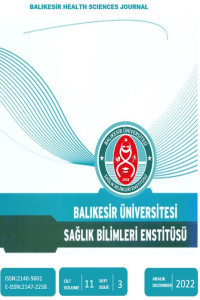HALLUKS RİJİDUSTA KULLANILAN TEDAVİ SEÇENEKLERİ
Halluks rijidus 1. metatarsofalangeal (MTF) eklemin dejeneratif ve ilerleyici artiritine bağlı gelişen ağrı, dorsifleksiyon kısıtlılığı ve dorsal osteofitlerle karakterize bir hastalıktır. Hastalığın tedavisi klinik şiddeti ve evresine göre değişmektedir. Hastalığın erken döneminde konservatif tedavi tercih edilirken geç dönemde cerrahi tedavi tercih edilmektedir. Tüm hastalar için geçerli olan tek bir standard cerrahi tedavi bulunmamaktadır. Halluks rijidusun cerrahi tedavisi hastanın yaşına, aktivite düzeyine ve cerrahi tedaviden beklentisine göre değişmektedir. Bu derlemede güncel literatürler eşliğinde halluks rijidus tedavi seçenekleri irdelenmiştir.
Anahtar Kelimeler:
Halluks rijidus, osteotomi, çelyektomi, artrodez
TREATMENT OPTİONS İN HALLUX RİGİDUS
Hallux rigidus, is a dissease charactherized by the pain on the 1 metatarsophalangeal (MTP) joint due to the degenerative and progressive arthiritis and the formation of dorsal osteophytes also accompanied by the limitation of the toe dorsiflexion. Clinical appearence and the treatment depends on the stage of the disease. While conservative treatment is preferred for the early stage of the disease, surgical treatment is preffered for the late stages of the disease. There is no single standard surgical treatment for all patients. Surgical treatment of hallux rijidus varies according to the patient's age, activity level, and patients’ expectations. In this article, current treatment options for halluks rigidus are evaluated due to the current concepts in the recent literature.
Keywords:
Hallux rigidus, osteotomy, cheilectomy, arthrodesis,
___
- 1. Wülker N, Rudert M. Hallux rigidus. J Foot Ankle Surg. 1999;5:61-71
- 2. Giannini S, Ceccarelh F, Faldini C, Bevom R, Grandi G, Vannim F: What's new in surgical options for hallux rigidus?. J Bone Joint Surg Am. 2004; 86-A Suppl 2:72-83.
- 3. Orthopaedic Knowledge Update: Foot and Ankle 3, 2003.
- 4. Shereff MJ, Baumhauer JF: Hallux rigidus and osteoarthrosis of the first metatarsophalangeal joint. J Bone Joint Surg Am 1998;80(6):898-908.
- 5. Hattrup SJ, Johnson KA. Subjective results of hallux rigidus following treatment with cheilectomy. Clin Orthop Relat Res. 1988;226:182–191.
- 6. Yetkin H, Kanatlı U, Songür M. Halluks Rijidus’ta güncel tedavi yöntemleri.TOTBİD Dergisi 2006;6;Sayı3-4:95-100
- 7. Haddad SL: Hallux Rigidus. In: Operative Treatment of the Foot and Ankle, Kelikian AS(ed), Appleton & Lange, Connecticut, 1999,127-46
- 8. Kalish SR, Willis FB. Hallux Limitus and dynamic spliting:A retrospective series. The Foot and Ankle Online Journal 2(4):1
- 9. Coughlin MJ, Shurnas PS: Hallux rigidus. Grading and longterm results of operative treatment. J Bone Joint Surg Am 2003, 85-A(11):2072-88.
- 10. Lundeen RO, Rose JM. Sliding oblique osteotomy for the treatment of hallux abducto valgus associated with functional hallux limitus. J Foot Ankle Surg.2000;39:161-7.
- 11. Youngswick FD. Modifications of the Austin bunionectomy for treatment of metatarsus primus elevatus associated with hallux limitus. J Foot Surg. 1982;21:114-6.
- 12. Roukis TS. Clinical Outcomes after Isolated Periarticular Osteotomies of the First Metatarsal for Hallux Rigidus: A Systematic Review .Journal of Foot and Ankle Surgery.2010;49(6):553-560.
- 13. DuVries HL. In: Surgery of the foot. St. Louis: Mosby; 1959. p. 392.
- 14. Meyer JO, Nishon LR, Weiss L, Docks G. Metatarsus primus elevatus and the etiology of hallux rigidus. J Foot Surg. 1987;26:237-41.
- 15. Mann RA, Clanton TO. Hallux rigidus: treatment by cheilectomy.J Bone Joint Surg Am 1988;70(3):400–6.
- 16. Easley ME, Davis WH, Anderson RB. Intermediate to long-term follow-up of medial-approach dorsal cheilectomy for hallux rigidus.Foot Ankle Int 1999;20(3):147–52.
- 17. Taranow WS, Moore JR. Hallux Rigidus :A Treatment Algorithm. Techniques in Foot and Ankle Surgery. 2012;11(Issue 2):65–73
- 18. Kilmartin TE. Phalangeal osteotomy versus first metatarsal decompression osteotomy for the surgical treatment of hallux rigidus: A prospective study of age-matched and condition-matched patients. J Foot Ankle Surg. 2005.Jan-Feb;44(1):2-12
- 19. Roukis TS. Outcomes after Cheilectomy with Phalangeal Dorsiflexory Osteotomy for Hallux Rigidus: A Systematic Review. Journal of Foot and Ankle Surgery.2010 49(5):479-487.
- 20. Taranow WS, Moutsatson MJ, Cooper JM. Contemporary approaches to stage II and III hallux rigidus: the role of metallic hemiarthroplasty of the proximal phalanx. Foot Ankle Clin. 2005;10:713–728.
- 21. Yee G, Lau J. Current concepts review: hallux rigidus. Foot Ankle Int. 2008;29:637–646.
- 22. Furhman RA, Wagner A, Anders JO. First metatarsophalangeal joint replacement: the method of choice for end-stage hallux rigidus? Foot Ankle Clin N Am. 2003;8:711–721.
- 23. Olms K, Dietze A. Replacement arthroplasty for hallux rigidus:21 patients with a 2-year follow-up. Int Orthop. 1999;23:240–243.
- 24. Roukis TS, Townley CO. BIOPRO resurfacing endoprosthesis versus periarticular osteotomy for hallux rigidus: short-term follow-up and analysis. J Foot Ankle Surg. 2003;42:350–358.
- 25. Carpenter B,Smith J, Motley T, Garrett A. Surgical Treatment of Hallux Rigidus Using a Metatarsal Head Resurfacing Implant: Mid-term Follow-up. J Foot Ankle Surg. 2010;49(4):321-325.
- 26. Marks RM. Arthrodesis of the first metatarsophalangeal joint. Instr Course Lect. 2005;54:263–268.
- 27. Fitzgerald JAW. A review of long-term results of arthrodesis of the first metatarsophalangeal joint. J Bone Joint Surg Br. 1969;51:488-93
- 28. Hunt KJ, Ellington JK, Anderson RB, et al. Locked versus nonlocked plate fixation for hallux MTP arthrodesis. Foot Ankle Int. 2011;32:704–709.
- 29. Beertema W, Draijer WF, van Os JJ, Pilot P. A retrospective analysis of surgical treatment in patients with symptomatic hallux rigidus: long-term follow-up. J Foot Ankle Surg.2006;Jul-Aug;45(4):244-51.
- 30. Kim P, Hatch D, DiDomenico L, Lee M, Kaczander B, Count G, Kravette M. A Multicenter Retrospective Review of Outcomes for Arthrodesis, Hemi-Metallic Joint Implant, and Resectional Arthroplasty in the Surgical Treatment of End-Stage Hallux Rigidus. J Foot Ankle Surg.2012;51(1):50-56.
- ISSN: 2146-9601
- Yayın Aralığı: Yılda 3 Sayı
- Başlangıç: 2012
- Yayıncı: Balıkesir Üniversitesi
Sayıdaki Diğer Makaleler
TERM YENİDOĞANDA KENDİLİĞİNDEN DÜZELEN SAFRA ÇAMURU; BİR OLGU SUNUMU
Selçuk YAZICI, Bahar YANIK KEYİK
HALLUKS RİJİDUSTA KULLANILAN TEDAVİ SEÇENEKLERİ
Gökhan MERİÇ, Aydın BUDEYRİ, Koray BAŞDELİOĞLU, Aykut DEMİR, Ali Engin UYSAL
OMEGA–3 YAĞ ASİTLERİNİN BÖBREK ANTİOKSİDAN SAVUNMA SİSTEMİ ÜZERİNDEKİ ETKİSİ: DENEYSEL BİR ÇALIŞMA
Burak GÜLCEN, Ömür KARACA, Murat Abdulgani KUŞ, Dilara KAMAN, Murat ÖGETÜRK, İlter KUŞ
